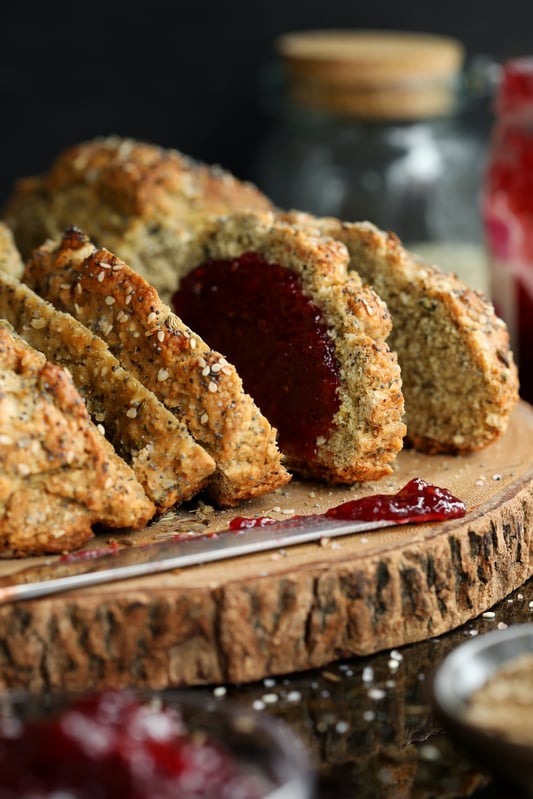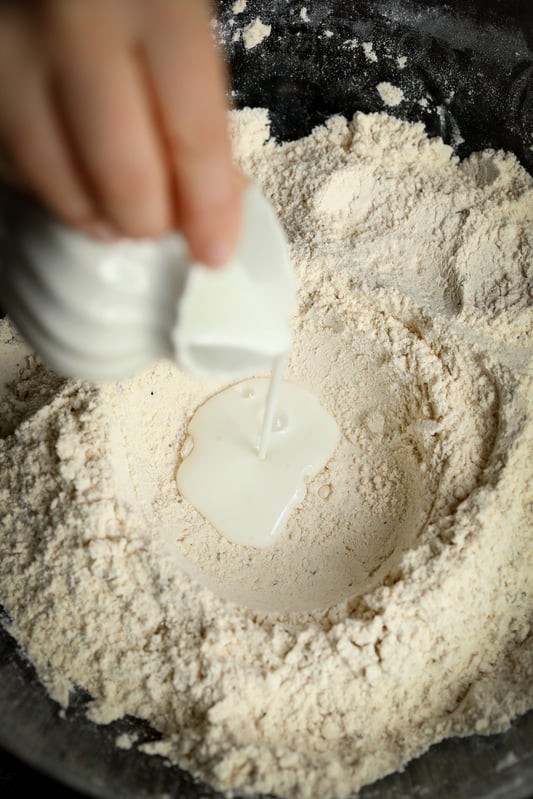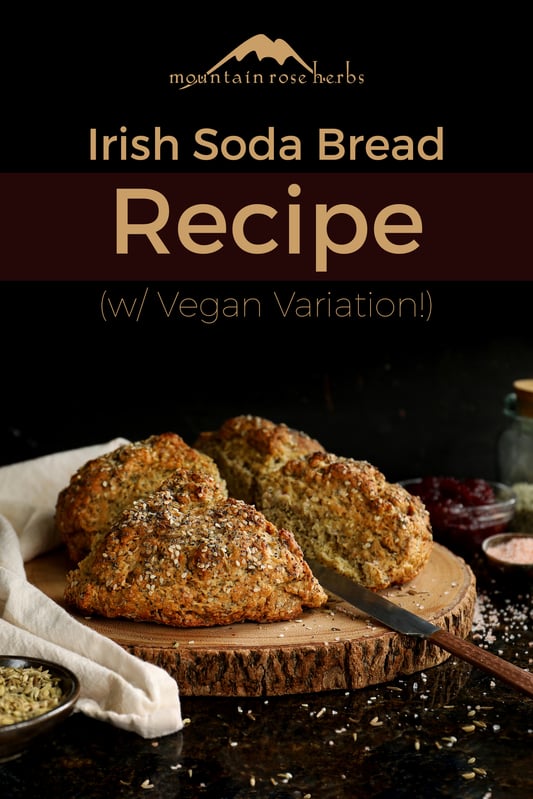
St. Patrick’s Day is one of those holidays that delights the comfort-foodie in me. Within my circle of friends, it’s been known to inspire Jameson-fueled quests to perfect the finer points of Irish soda bread. Although people often think of soda bread as being a product of Ireland, it’s actually an American invention that shows up in many cuisines around the world because of its simplicity, and the results are SO good! It’s a quick, one-bowl process and, because it relies on a chemical reaction between baking soda and a moist acid like buttermilk, the bread requires no resting or rising. In truth, soda bread is more or less a big biscuit. This five-seed, Himalayan-salted version retains the super-easy nature of traditional soda bread while seriously upping the nutritional content and flavor by adding whole wheat pastry flour and aromatic seeds. Whether you’re aiming for a perfect St. Patrick’s Day loaf, or you just want to try your hand at one of the world’s simplest bread-baking methods, this seeded soda bread may be just the answer!
Soda bread also makes a great addition to busy weekday dinners, and when you’ve got the hang of it, it’s fun to play with the ingredients. For instance, trade out the seeds and salt for cinnamon, sugar, and currants to make a sweet “American-style” bread to accompany a weekend breakfast. Whatever you decide, the key to the perfect loaf is knowing something about the protein content of your flour, and a couple little baking hacks that will help you get the crisp crust and moist crumb that marks a truly good soda bread. By understanding the basic chemistry of this bake, you can even make a dairy-free version of this classic recipe by substituting in some homemade vegan buttermilk!
Best Soda Bread Basics: What You Need to Know
Not All Flours Are Created Equal
The protein content of your flour matters when making soda bread. Every type of flour is milled to have a specific protein content. The more protein, the “stronger” or “harder” the flour. Softer flour has weaker gluten, which gives baked goods like cakes, cookies, and pastries a more delicate texture. As with cakes and cookies, quick breads like soda bread rely on a chemical reaction to produce carbon dioxide bubbles that expand in the heat of an oven and cause the bread to rise. Soft flours are ideal for this, which is why soda bread became so enormously popular in Ireland in the 1840s when baking soda was first introduced from the United States. As the climate in Ireland is not conducive to hard wheat, the soft wheat grown by this island nation produces a soft, low protein flour that is perfect for the use of baking soda. The lesson here: don’t use bread flour in soda bread! Bread flour has too much protein and gluten. You want an organic, unbleached, all-purpose (AP) flour, the same kind you’d buy to whip up a birthday cake.
For a bread that's more dense in nutrition, but still light in texture, this recipe uses about half whole wheat pastry flour. Whole wheat pastry flour is milled from low-protein, soft wheat that adds whole grain nutrition without extra density. You may choose to use different flours according to your personal taste and ingredient preferences, but note that you may have to adjust the amount of buttermilk (or vegan buttermilk) you use if you substitute a lower gluten flour (read on for desired texture).
A Bit More Science to up Your Baking Game
- Add More Acid: Many soda bread recipes call for a bit of cream of tartar, which is a dry acid, to add a little extra lift to your bake beyond what the buttermilk and baking soda combination creates. Remember, the rise in soda bread is all about the chemical reaction. Adding that dry acid—cream of tartar—can enhance the reaction you’re looking for to achieve the best leavening action. I generally find that the traditional buttermilk/baking soda combination does just fine without cream of tartar, but I did find it to be a useful addition for helping to fill out the vegan variation.
Work That Butter: Remember when I said that soda bread is, more or less, a big biscuit? Incorporating a little butter into your flour is a sweet little hack you can borrow from biscuit making to add even more flaky appeal to your soda bread. Typically, biscuit bakers use cold butter, but slightly softened butter works great for soda bread. If making the vegan version, you'll want to make sure your vegan butter alternative is chilled enough to give it some firmness, as this will help you achieve the crumbly flour texture desired.
Don’t Overdo the Dough: The more you mix your bread batter, the more gluten you are developing. Gluten is fantastic for yeast-risen, chewy loaves, but it’s the antithesis of what you want for a tender, soft quick bread. So, when the recipe says to stir just until the ingredients come together, don’t be tempted to keep going.
5-Seed Irish Soda Bread
Makes one 8 to 10-inch round loaf.
Traditional Soda Bread Recipe
Ingredients
- 2 cups organic unbleached all-purpose (AP) flour, plus more for dusting
- 1 3/4 cups organic whole wheat pastry flour
- 2 tsp. baking soda
- 1 tsp. fine sea salt
- 3 Tbsp. unsalted organic butter, slightly softened
- 2 Tbsp. organic poppy seeds
- 3 Tbsp. organic hemp seeds
- 3 Tbsp. organic sesame seeds
- 1 tsp. organic caraway seeds
- 1 tsp. organic fennel seeds
- 1 3/4 cups organic buttermilk, plus more for brushing on top
- Organic cornmeal for dusting baking sheet
- 1/2 tsp. Himalayan pink salt, coarse
- 1 Tbsp. melted unsalted organic butter (optional)
Directions
- Preheat oven to 400° F, with rack placed in middle to upper-middle position.
- In a large bowl, sift together 2 cups AP flour with the whole wheat pastry flour, baking soda, and sea salt.
- Cut 3 tablespoons slightly softened butter into small cubes and work into the flour mixture with a fork or your fingers until the texture resembles coarse crumbs (see animation above for reference!).
- In a separate bowl, combine all seeds. Remove 2 teaspoons of the seed mixture and set aside to sprinkle on top of bread. Stir remaining seeds into flour mixture.
- Make a well in the center of the flour mixture. Pour in buttermilk.
- Starting in the center and working your way toward the outside of the bowl, stir with a fork until the flour is incorporated and the dough just comes together. Dough should be soft and hold together, but not look either dry and crumbly, or wet and sticky. If dough seems too dry, add additional buttermilk 1 tablespoon at a time until dough holds together.
- Turn the dough out onto a floured surface. Knead until dough just becomes cohesive and bumpy—12 to 14 turns—and can be shaped into a loose ball. Don’t knead until dough is smooth, or the bread will be tough!
- With floury hands, pat the dough into a tidy round about 8 inches in diameter and 2 inches high.
- Lightly sprinkle a baking sheet with cornmeal and center the dough in the middle.
- Score the top of the bread—using a knife large enough to cut across the surface, cut a cross or an “X” about 1 inch deep. This allows heat to penetrate the center of the bread for even baking.
- Lightly brush top of loaf with a little buttermilk (try to avoid letting too much drip to bottom of loaf, as these spots will burn slightly when baked).
- Combine Himalayan salt with reserved 2 teaspoons of seeds and sprinkle evenly over the top.
- Bake until golden brown and a tester comes out clean, 35 to 45 minutes. It should have a crusted top—if top begins to brown too quickly, cover with a loose sheet of foil for remainder of baking time.
- Remove from oven and place on a wire rack.
- Brush with optional melted butter.
- Cool to room temperature before slicing.

Vegan Soda Bread Recipe
Ingredients
- 2 cups organic cashew milk
- 2 Tbsp. organic apple cider vinegar
- 2 cups organic unbleached all-purpose (AP) flour, plus more for dusting
- 1 3/4 cups organic whole wheat pastry flour
- 2 tsp. baking soda
- 2 tsp. cream of tartar
- 1 tsp. fine sea salt
- 4 Tbsp. organic vegan butter alternative of choice
- 2 Tbsp. organic poppy seeds
- 3 Tbsp. organic hemp seeds
- 3 Tbsp. organic sesame seeds
- 1 tsp. organic caraway seeds
- 1 tsp. organic fennel seeds
- Organic cornmeal for dusting baking sheet
- 1/2 tsp. Himalayan pink salt, coarse
- 1 Tbsp. melted organic vegan butter alternative (optional)
Directions
- Create vegan "buttermilk" by combining cashew milk and apple cider vinegar in a bowl, stirring well, and letting stand 10 minutes while preparing other ingredients.
- Preheat oven to 400° F, with rack placed in middle to upper-middle position.
- In a large bowl, sift together 2 cups AP flour with the whole wheat pastry flour, baking soda, cream of tartar, and sea salt.
- Cut 4 tablespoons slightly softened butter into small cubes and work into the flour mixture with a fork or your fingers until the texture resembles coarse crumbs.
- In a separate bowl, combine all seeds. Remove 2 teaspoons of the seed mixture and set aside to sprinkle on top of bread. Stir remaining seeds into flour mixture.
- Make a well in the center of the flour mixture. Pour in 1 1/2 cups of vegan "buttermilk" mixture.
- Starting in the center and working your way toward the outside of the bowl, stir with a fork until the flour is incorporated and the dough just comes together. Dough should be soft and hold together, but not look either dry and crumbly, or wet and sticky. If dough seems too dry, add additional vegan buttermilk 1 tablespoon at a time until dough holds together.
- Turn the dough out onto a floured surface. Knead until dough just becomes cohesive and bumpy—12 to 14 turns—and can be shaped into a loose ball. Don’t knead until dough is smooth, or the bread will be tough!
- With floury hands, pat the dough into a tidy round about 8 inches in diameter and 2 inches high.
- Lightly sprinkle a baking sheet with cornmeal and center the dough in the middle.
- Score the top of the bread—using a knife large enough to cut across the surface, cut a cross or an “X” about 1 inch deep. This allows heat to penetrate the center of the bread for even baking.
- Lightly brush top of loaf with a little vegan buttermilk.
- Combine Himalayan salt with reserved 2 teaspoons of seeds and sprinkle evenly over the top.
- Bake until golden brown and a tester comes out clean, 35 to 45 minutes. It should have a crusted top—if top begins to brown too quickly, cover with a loose sheet of foil for remainder of baking time.
- Remove from oven and place on a wire rack.
- Brush with optional melted vegan butter.
- Cool to room temperature before slicing.
Pro Tips
- Apple cider vinegar isn't your only option for creating vegan buttermilk; white vinegar or lemon juice can also be used.
- I used cashew milk for my vegan buttermilk because I find the richness of its taste and consistency nicely analogous to actual buttermilk. You may choose to use a different plant milk, such as soy or almond, but know that not every alternative will work for this purpose. To find out if your plant milk is suitable for vegan buttermilk, mix 1/3 cup milk with 1 teaspoon vinegar, let sit 10 minutes, and then check for curdling. If you don't notice clumping on the surface of your mixture, you'll need to use a different plant milk.
- I learned to bake soda bread the old-school way: in a cast iron skillet, instead of on a baking sheet. If you’re interested, instead of using a baking sheet with cornmeal, butter an 8 to 10-inch cast iron skillet and place the round of dough in the center. Proceed as above.
- Why use unbleached flour? I’ll spare you my long diatribe about the 1906 Congressional Landmark Pure Food and Drug Act, which introduced flour bleaching with additives on a large scale in the United States. Suffice it to say that chemicals like chlorine, bromates, and peroxides are regularly mixed with freshly milled grains in order to remove natural pigments (along with a lot of healthful nutrients), and artificially whiten and age flour. These food bleaching agents are increasingly restricted or banned outside the United States. But here in the U.S. if the label on your flour doesn’t say unbleached, it is bleached in this manner. Happily, unbleached flour has made a comeback in recent years and is now readily available in most grocery store baking aisles. I always recommend using good quality unbleached flour only.
Want to try another excellent seedy recipe?
Try These Easy Grain-Free Seed Crackers!
You might also enjoy:














